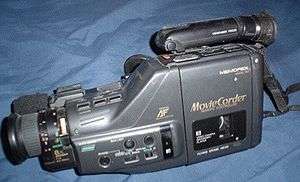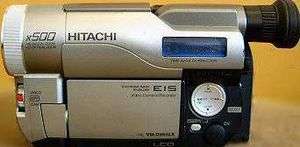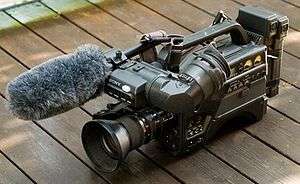8 mm video format
|
A Video8 videocassette | |
| Media type | Magnetic tape |
|---|---|
| Encoding | NTSC, PAL, SECAM |
| Capacity |
Video8/Hi8: 60 minutes (PAL-SP) 90 minutes (PAL-SP) 135 minutes (PAL-SP) 120 minutes (NTSC-SP) Digital8: 60 minutes (NTSC-SP) 90 minutes (PAL-SP) |
| Read mechanism | Helical scan |
| Write mechanism | Helical scan |
| Standard | Interlaced video |
| Developed by | Sony |
| Usage | Home movies |
The 8mm video format refers informally to three related videocassette formats for the NTSC and PAL/SECAM television systems. These are the original Video8 (analog recording) format and its improved successor Hi8 (analog video and analog audio but with provision for digital audio), as well as a more recent digital recording format known as Digital8.
Their user base consisted mainly of amateur camcorder users, although they also saw important use in the professional television production field.
In 1985, Sony of Japan introduced the Handycam, one of the first Video8 cameras with commercial success. Much smaller than the competition's VHS and Betamax video cameras, Video8 became very popular in the consumer camcorder market.
Technical overview
The three formats are physically very similar, featuring both the same magnetic tape width and near-identical cassette shells, measuring 95 × 62.5 × 15 mm. This gives a measure of backward compatibility in some cases. One difference between them is in the quality of the tape itself, but the main differences lie in the encoding of the video when it is recorded onto the tape.
Video8 was the earliest of the three formats, and is entirely analog. The 8mm tape width was chosen as smaller successor to the 12mm Betamax format, using similar technology (including U-shaped tape loading) but in a smaller configuration in response to the small configuration VHS-C compact camcorders introduced by the competition. It was followed by Hi8, a version with improved resolution. Although this was still analog, some professional Hi8 equipment could store additional digital stereo PCM sound on a special reserved track.
Digital8 is the most recent 8mm video format. It retains the same physical cassette shell as its predecessors, and can even record onto Video8 (not recommended) or Hi8 cassettes. However, the format in which video is encoded and stored on the tape itself is the entirely digital DV format (and thus very different from the analog Video8 and Hi8). Some Digital8 camcorders support Video8 and Hi8 with analog sound (for playback only), but this is not required by the Digital8 specification.
In all three cases, a length of 8mm-wide magnetic tape is wound between two spools and contained within a hard-shell cassette. These cassettes share similar size and appearance with the audio cassette, but their mechanical operation is far closer to that of VHS or Betamax videocassettes. Standard recording time is up to 180 minutes for PAL and 120 minutes for NTSC. (The cassette holds the same length tape; tape consumption is different between PAL and NTSC recorders.)
Like most other videocassette systems, Video8 uses a helical-scan 40mm head drum to read from and write to the magnetic tape.[1] The drum rotates at high speed (one or two rotations per picture frame—about 1800 or 3600 rpm for NTSC, and 1500 or 3000 rpm for PAL) while the tape is pulled along the drum's path. Because the tape and drum are oriented at a slight angular offset, the recording tracks are laid down as parallel diagonal stripes on the tape.
Unlike preceding systems, 8mm did not use a control track on the tape to facilitate the head following the diagonal tracks. Instead 8mm recorded a sequence of four sine waves on each video track such that adjacent tracks would produce one of two heterodyne frequencies if the head mistracked. The system automatically adjusted the tracking such that the two frequencies produced were of equal magnitude. This system was derived from the dynamic track following (DTF) used by the Philips Video 2000 system. Sony rechristened the system as automatic track following (ATF) as the 8mm system lacked the ability of the heads to physically move within the head drum.
The main disadvantage of the ATF system was that unlike in the case of a control track, an 8mm camera or player cannot keep track of where the tape is during fast forward and rewind (though it could during shuttle search). This made editing using a non linear editing system problematic. Some later cameras and players attempted to derive the tape position from the differential rotation of the spools with limited success.
Generations

Video8
Video8 was launched in 1985, into a market dominated by the VHS-C and Betamax formats.[2] The first model was the Sony Handycam CCD-V8, a record only model with no play back features, only three focus settings and a 6x zoom.[3][4][5] Soon after, an Auto-focus model was introduced.[6]
In terms of video quality, Video8 and Beta-II offer similar performance in their standard-play modes. In terms of audio, Video8 generally outperforms its older rivals. Standard VHS and Beta audio is recorded along a narrow linear track at the edge of the tape, where it is vulnerable to damage. Coupled with the slow horizontal tape speed, the sound was comparable with that of a low-quality audio cassette. By contrast, all Video8 machines used audio frequency modulation (AFM) to record sound along the same helical tape path as that of the video signal. This meant that Video8's standard audio was of a far higher quality than that of its rivals, although linear audio did have the advantage that (unlike either AFM system) it could be re-recorded without disturbing the video. (Betamax and VHS Hi-Fi rarely appeared on camcorders, except on the high-end models.) Video8 later included true stereo, but the limitations of camcorder microphones at the time meant that there was little practical difference between the two AFM systems for camcorder usage. In general, Video8 comfortably outperformed non-HiFi VHS/Beta.
Video8 has one major advantage over the full-size competition. Thanks to their compact size, Video8 camcorders are small enough to hold in the palm of the user's hand. Such a feat was impossible with Betamax and full-sized VHS camcorders, which operate best on sturdy tripods or strong shoulders. Video8 also has an advantage in terms of time, because although VHS-C offers the same "palmcorder" size as Video8, the VHS-C tapes only hold, at most, 45 minutes of tape in SP speed. Thus, Video8's 120-minute capacity served well for most users during its peak. (Both machines include longer playing modes at 120 and 240 minutes, respectively, but at the cost of reduced-quality images.) Longer sessions generally require additional infrastructure (line power or more batteries), and hence longer recording times offer little advantage in a true travelling environment.
Video8/Hi8's main drawback is that tapes made with Video8 camcorders cannot be played directly on VHS hardware. Although it is possible to transfer tapes (using the VCR to rerecord the source video as it is played back by the camcorder), this inevitably leads to degradation of the analog signal. During the 1990s Sony did market a few VHS VCRs that also feature an 8mm deck to allow convenient transfer to VHS.
Ultimately, Video8's main rival in the camcorder market turned out to be VHS-C, with neither dominating the market completely. However, both formats (along with their improved descendants, Hi8 and S-VHS-C) were nevertheless very successful. Collectively, they dominated the camcorder market for almost two decades before they were eventually crowded out by digital formats, such as MiniDV and 8cm DVD.
Hi8
To counter the introduction of the Super-VHS format, Sony introduced Video Hi8 (short for high-band Video8). Like S-VHS, Hi8 uses improved recorder electronics and media formulation to increase the recorded bandwidth of the luminance signal. Both Hi8 and S-VHS were officially rated at a luminance resolution of 400 lines,[7] a vast improvement from their respective base formats and are roughly equal to Laserdisc quality. Chroma resolution for both remain unchanged.[8]
Both S-VHS and Hi8 retain the audio recording systems of their base formats; VHS HiFi Stereo outperforms Video8/Hi8 AFM, but remains restricted to high-end machines. In the late 1980s, digital (PCM) audio was introduced into some higher-grade models of Hi8 (but never S-VHS) recorders. Hi8 PCM audio operates at a sampling rate of 32 kHz with 8-bit samples—higher fidelity than the monaural linear dubbing offered by VHS/S-VHS, but vastly inferior to VHS HiFi. PCM-capable Hi8 recorders can simultaneously record PCM stereo in addition to the legacy (analog AFM) stereo audio tracks.
The final upgrade to the Video8 format came in 1998, when Sony introduced XR capability (extended resolution). Video8-XR and Hi8-XR offers a modest 10% improvement in luminance detail. XR equipment replays non-XR recordings well, and XR recordings are fully playable on non-XR equipment, though without the benefits of XR.
All Hi8 equipment can record and play in the legacy Video8 format. The reverse is not usually the case though there are a few late-entry Video8 systems that recognize and play Hi8 recordings.
PCM Multi Audio
The Sony EV-S900 (Hi8), Sony EV-S800, Sony EV-S700U, and Pioneer VE-D77 (Video8) all support a mode called "PCM Multi Audio Recording". While other 8mm decks support only a single stereo PCM recording, these units provide five additional stereo PCM tracks that are recorded in the video area of the signal. This allows 8mm tapes to hold 6 parallel tracks of audio, each up to 4 hours long (in LP mode). Only one stereo track can be recorded or listened to at a time, and tracks are selected with the "PCM Multi Audio" selector button.
Digital8

Introduced in 1999, Digital8 is a form of the industry standard DV codec, recorded on Hi8 media. In engineering terms, Digital8 and MiniDV are indistinguishable at the logical format level. To store the digitally encoded audio/video on a standard NTSC Video8 cassette, the tape must be run at double the Hi8 speed. Thus, a 120-minute NTSC Hi8 tape yields 60 minutes of Digital8 video. Most Digital8 units offer an LP mode, which increases the recording time on an NTSC P6-120 tape to 90 minutes.
For PAL, the Digital8 recorder runs 1½ times faster; thus, a 90-minute PAL Hi8 tape yields 60 minutes of Digital8 video. PAL LP mode returns the tape speed to the Hi8 SP speed, so a Hi8 90-minute tape yields 90 minutes of Digital8 video.
Sony has licensed Digital8 technology to at least one other firm (Hitachi), which marketed a few models for a while; but as of October 2005 only Sony sells Digital8 consumer equipment. Digital8's main rival is the consumer MiniDV format, which uses narrower tape and a correspondingly smaller cassette shell. Since both technologies share the same logical audio/video format, Digital8 can theoretically equal MiniDV or even DVCAM in A/V performance. But as of 2005, Digital8 has been relegated to the entry-level camcorder market, where price, not performance, is the driving factor. Meanwhile, MiniDV is the de facto standard of the domestic digital tape camcorder market.
Digital8 recordings are not interchangeable with analog recordings, although many models of Digital8 equipment are able to play Hi8/Video8 analog recordings.
Tape and recording protection

As with many other video cassette formats, 8mm videocassettes have a tape-protecting mechanism built into the shell. Unlike the ones on VHS and VHS-C shells, which consist of only a single piece of plastic that protects the part of the tape that is read by the player/recorder, Hi8's tape-protection mechanism consists of two pieces of plastic at the top of the shell that come together and form a casing that protects both sides of the tape, and a latch that prevents this casing from opening and exposing the tape. The playback/recording unit can depress this latch to open the casing and gain access to the tape.
To prevent the recording on the tape from being erased, there is a small write-protect tab that can be moved to one of two positions, labeled "REC" and "SAVE". Comparing the sliding tab to a door, the tape is in the "REC" position when the "door" is open and in the "SAVE" position when it is closed. (Not all tape cases have markings for this information.) The tape can only be recorded onto (or recorded over) when this tab is in the "REC" position. This is an improved version of the VHS write-protect tab, which prevents erasure after it has been broken off, requiring covering with adhesive tape or filling with an obstruction to remove the write protection.
Video8 outside the camcorder market
The home market
Efforts were made to expand Video8 from only the camcorder market into mainstream home video. But as a replacement for full-size VCRs, Video8 failed. It lacks the long (5+ hours) recording times of both VHS and Betamax, offers no clear audio/video improvement, and cost more than equivalent full-size VCRs. Quite simply, there was no compelling reason to switch to Video8 for the home VCR application.
Initially, many movies were prerecorded in 8mm format for home and rental use, but the rental market for Video8 never materialized. Sony maintained a line of Video8 home VCRs well into the 1990s, but unlike VHS, 8mm VCRs with timers were very expensive.
Sony also produced a line of Video8 Walkman-branded players and recorders, with and without a flip-up screen meant for video playback and limited recording. These have been adapted for Digital8 as well as MiniDV formats, even as portable DVD players have become popular in this application. Such players saw use in professional applications, particularly with airlines, who, during the 1980s, adopted 8mm as the format for in-flight movies. As of 2008, they remain in use on many airliners.
Videography
Among home and amateur videographers, Video8/Hi8 was popular enough for Sony to make equipment for video editing and production. The format also saw some use in professional electronic news gathering and electronic field production.
Decline
By 2009, the popularity of the analog 8mm formats had dwindled considerably and new camcorders that support the format were unobtainable, having been superseded by digital formats, mainly MiniDV and 8 cm DVD. These in turn have been largely displaced by high-definition camcorders that record to flash storage cards. Both Video8 and Hi8 blank media remain available and affordable but are increasingly rare. Tape-based camcorders are still readily available in the second hand market. The last Hi8 camcorder (the Sony CCD-TRV238) and the last Digital8 camcorder (the Sony DCR-TRV285) were both discontinued in 2007, ending the 8mm format's 22 years.
Miscellaneous technical problems
Dropouts
In Video8 and its successors, the smaller head drum and tape make recorders more susceptible to the effects of "tape dropout", where magnetic particles are eroded from the tape surface. As the audio/video signal is contained in a smaller area on a Video8 tape, a single dropout has a more damaging effect. Hence, dropout compensation in Video8 systems tend to be more advanced in order to mitigate the format's vulnerability to dropouts. In this respect, VHS's and Betamax's larger head drums proved advantageous.
Lifespan of 8mm Tapes
8mm tapes should be stored vertically, out of direct sunlight, in a dry, cool, dust-free environment. As with any media, they will eventually deteriorate and lose their recorded contents over time, resulting in a buildup of image noise and dropouts. Tapes more than 15 years old may start to show signs of degradation. Among other problems, they can become sticky, jamming playback units, or become brittle and snap. Such problems will normally require professional attention.
However, the 8mm format is no more prone to this than any other magnetic tape format. In fact, the metal-particle technology used with the Video8 formats is more durable than the metal-evaporated type used with MiniDV. Hi8 tapes can be either of Metal Particle (MP) or Metal Evaporated (ME) formulation.
Because 8mm tapes use a metal formulation, they are harder to erase than the oxide tapes used with VHS, S-VHS, and Betamax tapes. As such, carefully stored, they are less susceptible to magnetic fields than the older formats.
See also
References
- ↑ Beeching, Steve (2001). Video and Camcorder Servicing and Technology. Newnes. ISBN 0-7506-5039-7.
- ↑ http://www.videomaker.com/videonews/2011/10/history-of-video-now-and-then
- ↑ http://www.sonyinsider.com/2010/05/24/sonys-handycam-camcorder-celebrates-its-25th-anniversary/
- ↑ http://www.digicamhistory.com/1984_1985.html
- ↑ http://www.sony.net/SonyInfo/CorporateInfo/History/sonyhistory-f.html
- ↑ http://www.digicamhistory.com/1984_1985.html
- ↑ http://electronics.howstuffworks.com/camcorder4.htm
- ↑ Beeching, Steve (2001). Video and Camcorder Servicing and Technology. Newnes. ISBN 0-7506-5039-7.
External links
- mediacollege.com video8
- ubergizmo.com sony ends support of 8mm video
- 8mmvideoplayers.com, 8mm Video Formats – What You Can And Cannot Do
- howstuffworks.com 8mm tape
- latimes.com Whatever happened to 8mm tape? : VIDEO'S 'FORMAT OF THE FUTURE' STILL LAGS BEHIND VHS, March 11, 1990|DENNIS HUNT | TIMES STAFF WRITER

